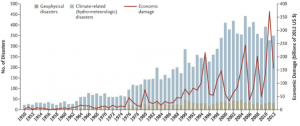With 2017 just a few weeks away, it is time to look ahead at what threats have the most potential impact to company security worldwide. Political tension, market instability and conflict escalation in several regions combined with the global economy have created more security risks for more companies. Knowing what the top threats today are will help as corporate security professional plan for 2017. In this post, Pinkerton’s Steve Ringhofer, Director, and James McClain, Vice President of Western Region and LATAM, provide the top security threats for next year.
Top Security Threat #1: lone wolf attacks and corporate travel
Orlando, Paris, San Bernardino; the list, unfortunately, goes on. Lone wolf attacks, those perpetrated by one person looking to inflict harm, even death, upon innocent people who are in the wrong place at the wrong time, are a global concern. In 2010, Leon Panetta, then the director of the Central Intelligence Agency (CIA), said that lone wolf attacks could pose “the main threat to this country.” But how are companies at risk?
“One overlooked issue is corporate travel,” says McClain. “You send an employee on a trip and an incident occurs. These events typically take place in populated areas that could very well be in the travel path of your employee. Your employee unwittingly becomes a part of it. Do they know how to react?” Training your frequent corporate travelers on protocols for remaining safe in what is a very unpredictable situation is a valuable exercise. “The priority is to get out of the situation as quickly as possible. Then, the employee should know that it is important to report their status and location to the appropriate, pre-defined person at the corporate office which in turn will trigger other notifications.”
Another concern raised by lone wolf attacks is when they occur at or near your facility. “Situational awareness is key, ” McClain says. “Many companies regularly conduct active shooter response training, which is invaluable when an incident occurs. People trained can not only protect themselves but lead others to safety, which can save lives and reduce the risks involved.
“The biggest problem with lone wolf attacks is that they are unpredictable and the attacker may not have a specific target, like a company or individual, in mind. But the motivation is irrelevant once the incident begins so, companies need to be aware of how vulnerable they are.”
Top Security Threat #2: natural disasters packing more punch
The Earth is a volatile, ever-changing planet where tornadoes, earthquakes and hurricanes wreak havoc on its lands, seas and inhabitants. However, as populations have grown and spread, the financial impact these events have had today has increased dramatically. We believe this current trend will continue in 2017. The chart below shows the steep incline in costs that natural disasters have had over the past 60+ years:

“Natural disasters can have a cascading effects on a business, ” says Ringhofer. “Your business can be directly impacted. Your employees’ homes could be affected. Parts of your supply chain could go down. Your customers could be hit or their customers could, both of which impact your business. No longer are the impacts of natural disasters regional, they are global. It opens a company up to far more risks.”
As we have written about previously, the best way to mitigate these impacts is to have a well-practiced disaster recovery plan. “Being aware of potential impacts is important but so is knowing what to do when disaster strikes.”
Top Security Threat #3: market instability and conflict escalation
New markets can represent the potential for a strong return on investment for companies and their shareholders. However, this can sometimes force companies to expand their operations into regions rife with political and social unrest, crime and other dangerous conditions.
“Once it is determined that expansion makes sense, executives will likely travel to the region for site visits, ” explains McClain. “New protocols for travelling need to be created and vetted. The best tool for helping mitigate risks is intelligence. Gathering reliable, locally sourced information that can shed light on the real situation a travelling employee will face, and how to avoid risks, is imperative.”
In 2016, regions across the globe experienced violent conflict, economic fluctuation and social unrest. England voted to leave the European Union. The United States experienced a highly divisive Presidential and Congressional election cycle. Italy’s Prime Minister failed at an attempt to change the government structure, resulting in his resignation. Emerging markets such as Brazil, Mexico and South Africa impacted the global economy.
Many factors determine the threats companies will face internationally in 2017. We recently developed our Risk Wheel Index and interactive map to help companies get an overview of what the threats and risks are for regions through the world. “The Risk Index has been really valuable for CSOs and others who have to determine how safe doing business in a certain country will be, ” says McClain. “It is a good start as companies complete due diligence research into an area.”
Top Security Threat #4: workplace violence
In February of 2016, a disgruntled employee in Kansas City opened fire on fellow employees, killing three and injuring 14 others. In May, an employee at a Katy, Texas, business shot and killed a co-worker and himself. In September, a Tennessee worker shot and killed his two supervisors. In October, a Roanoke, Va., man shot and killed a co-worker before killing himself. According to the US Bureau of Labor Statistics, from 2006 to 2010, an average of 551 workers per year were killed as a result of work-related homicides.
Security Magazine reported a survey that found two-thirds of respondents thought workplace violence and active shooters were the biggest threats they faced, yet nearly 80 percent were not prepared for it. “We believe the rising trend in workplace violence will continue in 2017, ” said McClain. “But we also believe companies are taking the threat far more seriously. Many more companies are training their employees for these situations and the employees have accepted that these types of situations could happen at their job.
“One factor we know can lead to more risk is company growth. When companies have to hire more employees, each new hire brings the potential for an incident. Without proper employment screening procedures, including background checks, the company is vulnerable.” McClain believes companies are still maturing through the process of workplace violence protection. “They are reacting instead of proactively providing training that can increase situational awareness. We believe that the issue, which is clearly important to them, should be discuss early on, before the hiring processes begin.”
The threats companies may face in 2017 are not new. However, the risk that they will have a major impact on businesses increases as companies grow, hire and move into new markets. Next year will see many surprises, too. Are you ready?





